| Unit | Size | Supported weight | Resistance | Console | Warranty |
|---|---|---|---|---|---|
HCI RXT-900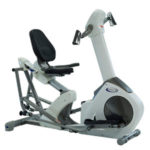 Check Discounted Price | L:60" W:25" H:52" | 300 lbs | Eddy current, 8 levels | 7 programs, Goals, Recovery | Frame: Lifetime Mechanical: 3 years Electrical: 3 years Labor: 1 year |
The HCI PhysioCycle RXT-900 is a hybrid fitness machine that combines the comfort of a recumbent bike with the pedaling motion of either a stepper or an elliptical. Also, its front handlebars are mobile, connected to an internal set of pulleys similar to the Stamina Elite Total Body recumbent bike, offering the possibility to perform arm-leg coordination exercises. It doesn’t offer online connectivity, but nonetheless, it’s a great fitness machine for recovery training and physiotherapy.
Technical Details and Specifications
- Assembled dimensions: 60L x 25W x 52H inches (152L x 64W x 132H cm)
- Assembled weight: 114 lbs (51.7 kg)
- Weight capacity: 300 lbs (136 kg)
- Handlebars: Mobile and stationary
- Seat: Adjustable
- Pedals: With straps
- Resistance: Eddy current, 8 levels
- Console: 7 programs, goal settings, recovery function
- Warranty: Frame lifetime / Parts 3 years / Electronics 3 years / Labor 1 year
Frame construction
The HCI Fitness PhysioCycle RXT-900 has a frame composed of two main parts. The front part integrates the 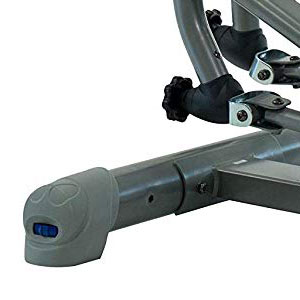 main pulley and the resistance system, while the rear part supports the seat assembly. These two parts connect at the middle, while the pedal bars also connect to each one of them.
main pulley and the resistance system, while the rear part supports the seat assembly. These two parts connect at the middle, while the pedal bars also connect to each one of them.
Most of the bars within the machine’s frame construction are made of steel with the exception of the seat rail which is aluminum-made. All the steel tubes are coated with a corrosion-resistant and chip-resistant paint finish; the main color used is gray. Of course, the construction of this recumbent exercise bike also includes several ABS covers, but these only fulfill a protective role, preventing dust or sweat to get to the internal components. The bike’s overall construction is very sturdy being rated for a user weight capacity of 300 lbs (136 kg).
The PhysioCycle RXT-900 is a fairly large fitness machine, compared to other recumbent bikes. It is approx. 60″ (152.4 cm) long, and 25″ (63.5 cm) wide. Plus, it is recommended to leave at least two feet of clearance all around it for ease of access. Also, its highest point is approx. 52″ (132 cm), given by the top of the console.
The bike is fairly heavy; with all the parts assembled, it weighs approx. 144 lbs (51.7 kg). All this weight results in excellent stability, though. Plus, its rear base has integrated adjustable stabilizers, so you can perfectly level the unit on any type of floor.
Despite its weight, the machine is not too difficult to move once it is assembled. Its front base features two small transport wheels which facilitate its relocation. By lifting it from its rear part and using these wheels, you will basically be handling less than half of its total weight.
One last aspect to mention here regards the bike’s step-through design. Although it’s only a partial step-through because you still have to step over the one pedal in order to take a seat, the unit’s design still offers a very easy access to the seat. Therefore, even users with certain disabilities should be able to take a seat or exit the bike without too much difficulty.
Seat and handlebars
The HCI PhysioCycle RXT-900 is equipped with a seat designed for comfort. Both its backrest and bottom part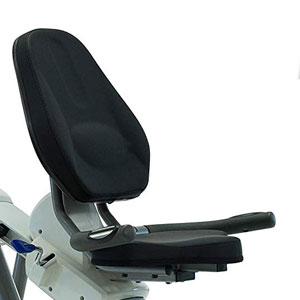 integrate a thick layer of foam cushioning; they’re both contoured and have a durable upholstery. The supporting frame of the seat is made of steel tubing, but most of it is concealed by a set of ABS covers.
integrate a thick layer of foam cushioning; they’re both contoured and have a durable upholstery. The supporting frame of the seat is made of steel tubing, but most of it is concealed by a set of ABS covers.
The whole seat assembly is adjustable. It is attached to an oblique, wide aluminum rail which is rated for a load capacity of 300 lbs (136 kg). The adjustment system is lever-based which means you can easily adjust its position while seated; you don’t have to exit the bike in order to position it. The rail offers 11 adjustment positions for the seat, so the bike can accommodate comfortably users between 4’10” and 6’3″ (147 – 190 cm) promoting a complete leg extension.
In case you’re wondering, the backrest does not recline, nor it adjusts separately from the rest of the seat. It’s directly attached to the seat frame and moves along with the seat on its adjustment rail.
In terms of handlebars, this PhysioCycle has two sets. One is fixed, attached to the seat assembly, the other one is mobile, attached at the top of the console mast. The fixed handlebars integrate metallic pulse sensors. The front handlebars can be rotated forward or backward. They are attached to a set of two pulleys connected to the main pedal assembly through a long belt which passes through the console mast. This being said, they cannot be locked in a stationary position. They will move for as long as you pedal. Also, the pedals will move for as long as you spin the front handlebars.
The moving handlebars feature ergonomic grips. They only have a one-grip design, allowing the user to adopt a vertical, slightly oblique grip.
Elliptical function and stepper function
The PhysioCycle RXT-900 is equipped with two large pedals made of heavy-duty ABS material. They have a 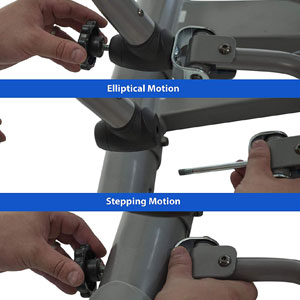 non-slip surface and an inner border for extra foot stability. They slide on two wide aluminum rails which connect to the main crank arms and the rear pedal bars. The base of each pedal has a set of small wheels for smooth front-to-back sliding motion.
non-slip surface and an inner border for extra foot stability. They slide on two wide aluminum rails which connect to the main crank arms and the rear pedal bars. The base of each pedal has a set of small wheels for smooth front-to-back sliding motion.
The long pedal bars can be attached in two ways to the rear section of the bike. If attached to the rear bottom base bar, the machine will provide a stepping motion. Conversely, if the long pedal bars are attached to the rear pivoting bars, the machine provides an elliptical motion. The pedal bars can easily be disconnected and reconnected to the desired position via two large knobs.
When the machine is set to its elliptical function, the pedaling motion will describe an ellipse slightly elevated at the front. This being said, the machine will deliver the feeling of going up a soft ramp.
If the bike is set to stepper mode, the sliding motion of the pedals on their rails will be reduced and your feet will follow an up/down path, pretty much similar to a stepper.
In case you’re wondering, standing on the pedals is not recommended. The RXT-900 is designed for seated workouts only. Thus, even though the pedals may support your full bodyweight with no problem, the stand-up posture on this physio cycle is very awkward.
Drive and resistance
The PsysioCycle RXT-900 is equipped with a perimeter-weighted flywheel. This type of construction provides extra stability to the rotating motion which results in a very smooth pedaling feel. The weight of the flywheel is not specified, but as a general idea, it should be between 10 and 20 lbs. (4.5 – 9.0 kg).
extra stability to the rotating motion which results in a very smooth pedaling feel. The weight of the flywheel is not specified, but as a general idea, it should be between 10 and 20 lbs. (4.5 – 9.0 kg).
The flywheel is bi-directional. This being said, the machine offers the possibility of pedaling in reverse. This also stands for the front mobile handlebars which are connected to the units main drive system.
The bike uses a poly-v, heavy-duty belt as its main drivetrain. This being said, internal maintenance such as lubrication is not needed. Also, a belt generates much less vibration than a chain which contributes to the overall smoothness and quietness of the ride.
The HCI PhysioCycle RXT-900 elliptical recumbent bike features an eddy current resistance system. This means you have to connect it to a power source in order to be able to adjust the pedaling tension. A power adapter with cable is included. Also, its important to mention that the resistance can only be adjusted from the console.
The bike’s resistance system consists of a magnetic mechanism integrated into the flywheel and a servo motor. When you select a certain pedaling difficulty from the console, the motor adjusts the magnetic pull which results in more or less drag. The resistance system offers 8 distinct tension levels. But as a general idea, since this is a physiotherapy bike, the top resistance level doesn’t offer a super high pedaling difficulty.
Console
This HCI Fitness trainer is equipped with a mid-range console. It doesn’t have fancy features such as an 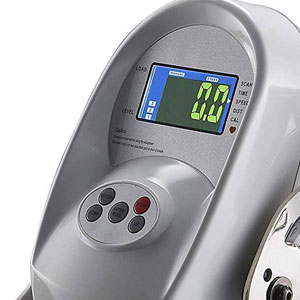 integrated sound system, cooling fans, or online connectivity. However, it does offer 7 workout programs, goal settings, and several other features.
integrated sound system, cooling fans, or online connectivity. However, it does offer 7 workout programs, goal settings, and several other features.
To begin with, the bike’s console has an LCD display with incorporated LED backlight which tracks time, speed, distance, calories, pulse, and also indicates the selected resistance level. Speed and distance can only be displayed in imperial units; there is no metric setting. Also, in order to track your pulse rate, you have to hold on to the sensors built-in the grips of the seat handlebars. The console cannot track your pulse through a wireless chest strap.
The workout programs are 7 in number. The first one (P1) is the Manual program. This gives you the possibility to pedal freely and adjust the resistance as you like during your session. The P2-P6 programs are preset. They cover different workouts including Interval, Valley, Mountain, Ramp, and Hills. The P7 program is heart rate based. It allows you to select a target heart rate between 90 and 220 BPM, and the console will increase or decrease the resistance automatically based on your current pulse in order to keep you within the selected target heart rate.
Goal settings for time, distance, and calories are available as well. By selecting a goal for any of these metrics, the console will show the remaining value from the selected goal.
Finally, a Recovery function is also available. When it is initiated, the console will measure how quickly you return to a resting heart rate after exercising, and based on that result it will give you a fitness rating between F1 (best) and F6 (worst). Of course, in order to use this function, you have to hold on to the pulse sensors.
Assembly and Maintenance
The bike’s drive and resistance elements are already assembled; the front section of the bike with the flywheel, the crank, the main mast, and the console is already in one piece. Therefore, the assembly only requires you to connect the two main frame pieces together, attach the base bars, the pedals with all their bars, the seat parts, and the front mobile handlebars. This may take up to two hours. However, the manual provides very clear assembly instructions and all the tools required are included.
Once the unit is fully assembled, maintenance does not require much. You only have to keep it clean, and maybe lubricate the joints from time to time.
The Pros
- Sturdy frame – can support users up to 300 lbs;
- Professional-looking design;
- Transport wheels on the front base;
- Adjustable stabilizers on the rear base;
- Quick lever-based seat adjustment mechanism with 11 positions;
- Cushioned, contoured seat and backrest for maximum comfort;
- Seat handlebars with pulse sensors;
- Mobile, bi-directional front handlebars;
- Large pedals with a sliding mechanism for a smooth elliptical motion;
- Two workout modes – elliptical and stepper;
- Eddy current, full digital resistance adjustment system with 8 distinct levels;
- Silent belt drive;
- Fairly heavy, perimeter weighted flywheel for a steady and consistent pedaling feel;
- 7 available workout programs;
- Goal settings for time, distance, and calories;
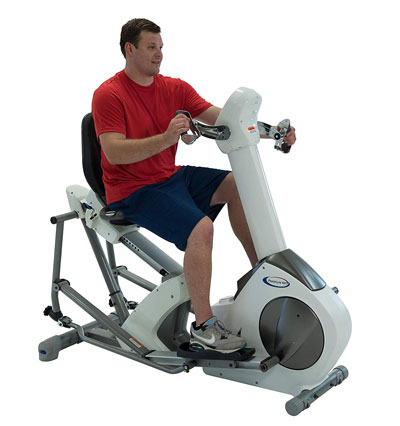
- Recovery function included;
- Bottle holder included;
- Fairly easy to assemble;
- Little maintenance required;
- Excellent warranty.
The Cons
- No incorporated sound system;
- No online connectivity;
- The console cannot read your pulse through a wireless HR chest strap.
Summary
The HCI Fitness PhysioCycle RXT-900 is an elliptical recumbent bike which also offers a stepper function. It offers 8 levels of eddy current automatic resistance, superior micro-adjustability, and comfort, as well as a bi-directional rotating handlebar. It’s an excellent trainer for recovery training, physiotherapy, light cardio training, interval training, stamina development, and even weight loss. And finally, it’s not exactly one of the most affordable trainers, but definitely offers great value for the price.

